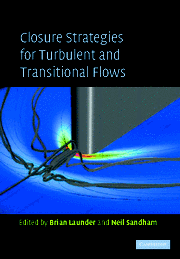18 - New Strategies in Modelling By-Pass Transition
Published online by Cambridge University Press: 06 July 2010
Summary
Introduction
The preceding chapter [17] has discussed the various earlier attempts to predict by-pass transition using conventional turbulence-model closure schemes across the full range of complexity from simple mixing-length/correlation approaches to Large Eddy Simulations (LES). A perspective has thus been provided on the state-of-the-art as evidenced by research journal publications and actual industrial applications, which accurately reflects developments in both academia and industry during the twenty-year period from the early 70s to mid 90s.
However, over the last five years a number of existing established methodologies have been significantly refined in the light of improved physical understanding emerging from further experimental studies and, more especially, new numerical database developments. Moreover some additional alternative approaches have also now been proposed, researched and, in some cases, tested with greater success. It is these newer strategies for turbulence modelling of by-pass transition, which have not yet reached either the archival research literature or full industrial implementation, that form the subject of the present review.
Results from by-pass transition simulations
A number of (fully resolved) simulations have now been carried out for flows undergoing by-pass transition. Some initial rather coarse mesh zero pressure gradient Direct Numerical Simulations performed by Yang and Voke for the 1st ERCOFTAC Workshop – see Pironneau et al. (1992) – in fact very accurately reproduced the experimental behaviour observed in experimental test cases with 3 and 6% free-stream turbulence (fst). Encouraged by this success, a large amount of the UK National Supercomputer resources (more than 10,000hr CPU on a Cray YMP) has been devoted to establishing a sufficiently fine mesh by-pass transition simulation database for a (T3BLES) Test Case similar to the Rolls-Royce T3B (6%fst) experiment. In order to avoid the sub-grid-scale modelling approximations as far as possible, this simulation has been run as a Direct Numerical Simulation so far as the low-Re transitional boundary layer is concerned, but a Smagorinsky-type SGS model has been employed to simulate the development of the higher Re free-stream turbulence which was extracted from a precursor simulation.
In addition Yang and Voke have now also performed a number of coarser mesh Large-Eddy Simulations for the ERCOFTAC T3A, T3B, T3C1, T3D2 & T3L Test Cases – see Table 1 of [17] and Savill (1995).
- Type
- Chapter
- Information
- Closure Strategies for Turbulent and Transitional Flows , pp. 493 - 521Publisher: Cambridge University PressPrint publication year: 2002
- 7
- Cited by



